Kathleen M. Basi's Blog, page 5
October 20, 2021
Creation: a chiropractic adjustment for the soul
My calendar for the next two weeks has written all across it in big block letters, “KEEP FREE FOR OUTSIDE.” I was expecting peak color this week, but the trees are stubbornly clinging to green. I think I might have to add a week to my blocked-off schedule. Hike, bike, kayak: this is a priority for this time of year.

I was out yesterday morning on Perche Creek (you do pronounce the “e,” and it turns out its name came from Lewis & Clark naming an arch rock along the banks of said creek: Roche Percée, or pierced rock). I’ve been thinking about this for a while. I have only ever taken my kayak to the water trail and to the lake down the road from the farm. But I wanted to try getting on the big creek, a mile or so upstream from where it empties into the Missouri, and see what that was like. So that’s what I did.
Too often, lately, I’ve brought my computer with me when I go out to nature. And then I spend my sitting time either working or feeling like I should be working. The kayak is great, because you don’t take electronics in a kayak. I felt free to stop paddling and let the wind turn me whichever way it liked.
Magical things happen when you take time to sit still and pay attention. In the past few years I’ve had a close brush-by with a beaver that was in a Lewis Carroll-worthy rush; been mesmerized by hawks circling lazily on the breezes; encountered a blue heron; learned to identify trees I never knew as a child; discovered springs—tiny little springs, chattering out of rocks or holes in the ground; had a bicycle race with an indigo bunting; watched a raccoon take a mid-morning swim in a creek and a deer scramble and slip on the ice, uncharacteristically clumsy as it tried to get up the embankment. And a few other, less presentable animal encounters. 
 Wild and messy and oh so real
Wild and messy and oh so realBy visiting these places over the course of years, I learn things about my home territory I never knew. I watch the plants grow, get washed away by flash floods, and grow back. I am fascinated by the trees holding firm on the edge of streams whose waters can rage and can be as still as glass—and by the trunks and branches, stripped bare and sticking up from the yellow-brown waters, that prove that the trees don’t hold forever.
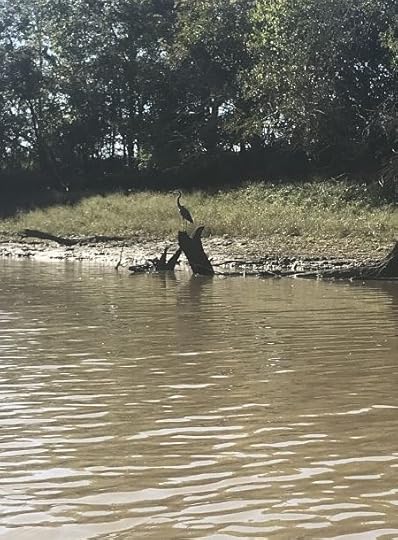
Yesterday, a heron perched on a log, paying no apparent attention to me. But when I got too close for comfort, it stretched its wings and found another log farther downstream. It occurred to me that this heron is much like me. I wasn’t in its personal space. I was too far away to get a decent picture with the not-phone, in fact. But that heron wanted to be alone.
Unlike me, however, it had no self-consciousness about simply picking itself up and putting more space between us. Me? When people are too close to me, I feel obligated to stay, out of politeness. They might think I’m rude, or that I think there’s something wrong with them, when in reality the only thing it has to do with them is that I want to be alone.
This is the reason nature is so good for me. When I am sitting by a river, or drifting down a creek, I am constantly encountering things God made, doing precisely what God created them to do. Leaves rustling—maples with that soft-edged quality, cottonwoods with a sound much more angular and crispy. Hawks perched on dead trees, scanning the vicinity for food. A string of bubbles in the yellow-brown water alerting me that something is down there that I can’t see—turtle? fish? snake? —minding its own business, doing what it was meant to do. Twigs and walnuts and acorn tops (and bottoms), bobbing along the surface. Beads of light running up the curve of a fallen tree as the sunlight hits the water and bounces off.
Encountering the things of God acting in accord with their nature recalibrates me to better reflect my own purpose. It’s like a chiropractic adjustment for the soul.
October 4, 2021
Escapism and that amazing new version of “Emma”
Photo by cottonbro on Pexels.com
I doubt anyone will be shocked if I say I’ve always been a pretty serious person. I love movies and books and music that make me cry—that dig deep and explore human connection and emotion—that connect us to the REAL.
But the last two years have been hard, and as I’ve already blogged a couple times, the re-entry into post-shutdown world has been… intense. Because I am a masochist and I like to know just how much I have suffered, I went through my calendar. Between Easter and October 1st, we had 47 health-related appointments in our household.
FORTY. SEVEN. In SIX MONTHS.
And that is NOT counting any of Julianna’s speech therapy appointments, IEP-and-related meetings, or a single one of the kids’ activities. Let alone any of my own professional obligations, some of which have involved some pretty heavy emotional and mental lifting.
Normally, I am not a person who feels a great need for escapism. I normally lean in to the difficult, the deep, the real. But during this incredibly intense year—and I’ve said nothing about the toll the news cycle takes!—I have found myself craving the emotional rest of sheer escapism.
Of course, “escapism” means different things to different people. For my husband, escapism means lots of things exploding. But if I’m tired and stressed and overstimulated/over-extroverted, all that racket just aggravates my nerves further. It’s the same reason I not-so-cordially loathe sports. All that disorganized noise. I spend sporting events wearing earplugs and constantly coaching myself to take deep breaths. I can get into it, but it’s work.
For me, escapism means period pieces—most recently, Downton, Guernsey, and Austen. Pride & Prejudice has long been my favorite Jane Austen, but the new version of Emma, which I finally got to watch two weeks ago and have been more than mildly obsessed with ever since, has my loyalties shifting. At the moment I’m totally on Team Knightley. Emma, as a character, can be hard to handle (Jane Austen famously said she was creating a character no one could love but herself), but as novelists are frequently reminded, the mere existence of someone in a story who loves a difficult character makes that character a whole lot more lovable.
 From Emma, 2020 release
From Emma, 2020 releaseMy Emma escapism is good on many levels. Professionally, it reminds me how great the act of storytelling really is. It’s showing (not telling) me how to weave character and absurdity and flaws and romance into a wonderful tapestry that is uplifting and humorous and teaches an important truth about life, all at once. Personally, it just makes me happy.
But I’m discovering there’s a danger in it, too. If you can’t leave the escape world behind, you end up having trouble with reality. When I was newly married, I had to learn to separate the world of my novel characters from my marriage. Lately, my problem has been that I can’t focus on writing fiction because writing is hard. It’s much more enjoyable to go back and revisit all my favorite Emma-and-Knightley scenes. But when I do, I end up feeling guilty, because in my heart of hearts, my passion for my own characters is real, and I’m letting them down and setting myself up for failure–because I measure success by productivity.
So that’s the balance I’m working toward right now: The discipline to kick my own butt when I know I’m taking the easy way out, and the self-love to give myself grace when I truly do need a break from reality.
What’s your brand of escapism?
September 26, 2021
Age Rears Its Head

I am not one of those people who gets offended when you ask her age. (47, in case you’re wondering.) I think it’s silly to get bent out of shape. We are the age we are, and God willing, we’ve gained wisdom with age.
I take my cue from my paternal grandmother. Once, she told someone she was fifty-five, and I yelled, “Fifty-five? I thought you were NINETY-NINE!!!” She laughed so hard, she almost cried.(That’s one of those ridiculously vivid memories. I remember exactly where in her house we were standing, and in what configuration. Strange, the things that become foundational memories.)
Anyway.
I have the best eyes in my family. Or at least, I did until my older sister and my parents had corrective/cataract surgeries. But the best eyes in my family means 20/700 and 20/800, uncorrected.
So I have no angst surrounding aging eyes. I’ve known this day was coming for a while. When I was a kid, my mom used to go around crying, “How can you READ in that light????” and turning on lights. We all rolled our eyes. I’m happy to say that I do not scold my kids for reading in lower light than I think necessary, because I’m well aware that I need a heck of a lot more light now than I did ten years ago.
But for the past year and a half, I’ve been flirting with the line. Having to hold the book farther and farther away before the words will focus. Blowing things up on the screen to large fonts. Going crazy while trying to help my teenager with homework, because the school computers they give those kids are at least a third smaller than my laptop, and everything is proportionally smaller, and he keeps the brightness at about 50%. He got very angry with me during the COVID year, when he needed my help with DQs and LEQs and I don’t know what all nightmare of AP essay world. I had to have things brightened and enlarged, and he would yell, “But that wastes SO MUCH ENERGY!”
But I didn’t start wearing readers, because the 1.0s were too much, and I just didn’t get around to ordering .75s online. Even when I did, I put them on, shrugged and said, “Well, it’s brighter and bigger with these, and it doesn’t make me sick to my stomach to wear them, so it must be about right. But I don’t have to have them.”
Until one day, quite abruptly, midsummer 2021, I did.
There was no easing into it. It just happened, boom.
I’m now wearing my readers on chains when I go to choir, because I can’t read the music to play choral parts well enough without them, and if we’re learning a new(ish) song with a lot of words, I need to read them. The first day I wore them to Mass, at least three people came over to comment afterward. It was kind of comical, actually. But then, I started working at this parish at the tender age of 26, so I suppose all the people who were old enough for reading glasses then feel the weight of this transition at least as much as I do. 
My family mocks me constantly for the “old lady chains,” but I just have to shrug and go on, because—as I said above—my family has really bad eyes, and I have to do what I have to do.
This whole transition has sensitized me to other age-related realities. Without going into details that might off-put readers, let’s just say that there are times when I can see old age in my skin, to say nothing of what lies beneath it. I’ll leave that one there and move on to a related effect that I recognized years ago.
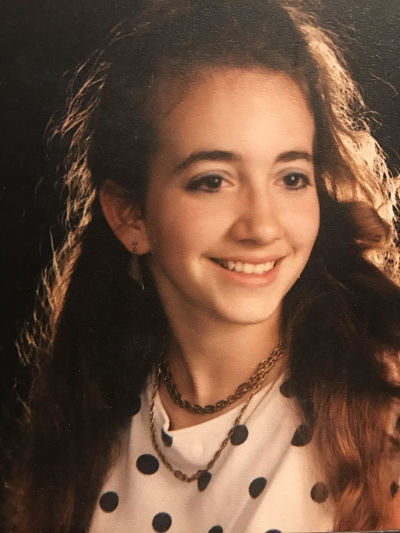 Look at that skin! I want to tell her, “Wear a hat!”
Look at that skin! I want to tell her, “Wear a hat!”
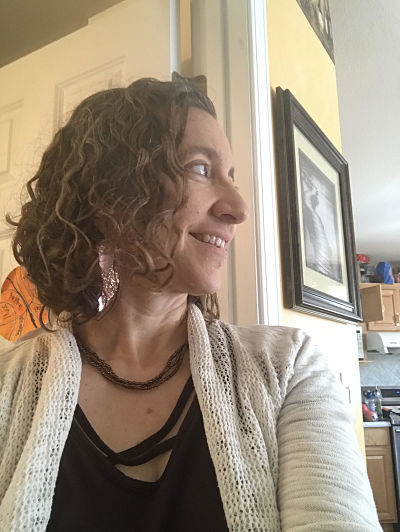 At least I know how to handle curly hair now. Mostly.
At least I know how to handle curly hair now. Mostly.I won’t go outside in the sun anymore without a hat that covers my whole forehead, because years of flute playing with my eyebrows raised has caused permanent etchings in my forehead and the last thing I need is to be making them worse by squinting.
In fact, what I asked for on my birthday this year was a wide brim to go over a bicycle helmet. Confession: I have never worn a bicycle helmet, ever. But I do recognize that I should. I just didn’t, because no bicycle helmet I have ever seen shades your eyes properly. My grubby old ugly visor protects my eyes and my forehead better. But, in an effort to set a good example for my kids, I asked for a helmet brim for my birthday. Of course, it was set up to provide more shade in the back than the front, which is idiotic. The whole point was to shade my eyes! So I am wearing it backwards.
(I sound just like my cantankerous grandmother. Whoa. Ahem.)
Again: much mocking from my family. “Do not EVER take a picture of yourself in that,” my husband said.
I wasn’t convinced for a while, honestly. The first day, the wind kept ripping the elastic brim off the helmet. I had to stop and turn around to retrieve it twice. The third time, I tightened it up until it snapped in so tight around the helmet, it’s never coming off. After that it acted like an airplane wing, and the wind tried to lift me off my bike altogether. I was about to pitch the whole thing when I submitted to the inevitable and realized I had to tighten the chin strap. I have a real problem with things that are tight under my throat. I have a bad gag reflex. But I told myself to grow up and leave it there, that I’d get used to it. And I did… mostly.
What’s the point of this blog post? TMI sharing, I suppose. It’s just bizarre to me to be facing such concrete proof of the aging process marching forward in myself.
August 24, 2021
The summer of discontent
I actually debated quite a while about which of my blogs was the best place to publish this. So I decided to reblog it here today.
 Photo by Monstera on Pexels.com
Photo by Monstera on Pexels.comAt the beginning of this year, I set myself a spiritual goal to focus on contentment.
I have not been incredibly successful.
Honestly, I didn’t expect to be. Some goals are set knowing they are beyond reach—knowing that the striving toward them brings one closer to God.
Still, it’s been a hard year to reach for contentment. The summer disappeared beneath a deluge of appointments, meetings, and a million other very worthy time constrains that are not writing time. Early July, a friend offered me an open invitation to sit in her screened-in gazebo by a creek—with wifi!—to work any day I wanted. “I can’t come tomorrow,” I said, “but I’ll be there the day after.”
It’s been eight weeks and I still haven’t had time.

During this same interlude, I began reading Shannon K. Evans’ new book, coming out next month—Rewilding Motherhood.
View original post 568 more words
August 20, 2021
Five on a Friday with Brianne Moore
One of the great things about being a published author is how many other authors I get to “meet.” We all hear about the big, flashy books by big-name authors, but there are a host of gems that may never cross our paths. (So many books… so little time!) I get to see some of those books these days as I help other authors, and I thought I’d use my little platform to feature some stories I’ve really enjoyed.
Today, please welcome Brianne Moore, author of “A Bright Young Thing,” which releases on September 7!


About the book:
In early 1930s England, a young firebrand finds herself on a fraught and dangerous road to independence.
In 1931 England, Astra Davies defies all the conventions. Clever, witty, and determined, Astra smokes, drinks, plays a mean piano, and gallivants around London with her beloved Cavalier King Charles Spaniel. But Astra finds herself in a tight spot when her parents die suddenly, leaving her with a raft of debts. With few marketable skills and a closet full of family secrets, Astra has two choices: find a rich husband or make her own way.
A fiercely driven woman like Astra is not about to cast her lot in with a man, especially out of desperation. And since the only man she fancies–Jeremy Harris, the Earl of Dunreaven–is as hard up as she is, her way forward is clear. But the path to independence is a bumpy one fraught with hazards and heartbreaking choices. A blackmailing socialite threatens to derail Astra’s reputation. A brainless business partner just might drive her even further into debt. And a series of bruising scandals dogs her every step of the way.
From the bustle of London to the country estates of the aristocracy, Astra embarks on a journey that tests her brains, wit, and mettle as never before. But one way or another, Astra Davies is dead set on proving she’s no ordinary Bright Young Thing.
Brianne, let me just start by saying how much I LOVED this book. I’ve enjoyed both of your books, actually, but this one really hit all my favorites. Tell us about the origin of “A Bright Young Thing.”
I started writing A Bright Young Thing way back in my senior year of college. So, we’re talking almost 20 years ago. I was initially inspired by Robert Altman’s film Gosford Park, which, like my book, is set in 1931. I loved the mood, the fashion (I must admit!) and was particularly intrigued by the side plot involving an ‘upstairs’ couple that seems to be struggling with money. I started to wonder what one would do, in that world, if you fell on hard times. And what would you do if you were a single woman, who had probably received very little in the way of a useful education?
Something that struck me was how Astra’s struggle to bring her inheritance into the modern world paralleled that of the Crawley women in Downton Abbey. That’s earlier than your book is set, but it really felt parallel. Am I right?
I watched the heck out of Downton Abbey! And you’re right, there is a parallel there. The inter-war period was a fascinating but also, I think, a really frustrating time for women. On the one hand, a lot of social constraints loosened up during and after World War I and women had greater opportunities to vote, socialise, work, and receive an education. But, just as we saw after World War II, there was also a lot of strong messaging telling women they belonged in the home after they married. So, on the one hand you have all these freedoms, but then you marry and a lot of it gets taken away. Unsurprisingly, there were many women who weren’t happy with that, and so they pushed back. But there were definitely struggles for women like Astra and the Crawleys, who found themselves caught in this push-pull between freedom and conventionality, between the lives they perceived they could be living and the lives they’d been prepared for by parents who were of a very, very different generation.
That generational divide is part of what makes Downton—and A Bright Young Thing!–so universally compelling. You’d think these were aimed directly at women, yet I know lots of men who watched Downton just as avidly. These days, when I’m re-watching, my husband will walk through the room and can’t seem to leave. The Dowager Countess always has him cracking up. Maybe she’s a modern construct, but I suspect there were plenty of Cousin Violets behind the younger women as they navigated this time.
Oh, there were definitely a lot of Violets throughout history! It’s important to remember that the social changes we saw in the inter-war period didn’t happen out of nowhere: they were the result of centuries and centuries of built-up frustrations of women like Violet who knew they were as smart and capable as any man but were prevented from fully and independently engaging with the greater world simply because they were women. Eventually, that frustration goes somewhere, and in a lot of ways the first World War was a major catalyst for change. It was a complicated time, but you definitely saw some truly amazing women come into their own, and although there was some shock and pearl clutching over their ascendency, it was accepted by enough people that we finally saw women really enter spheres that had previously been open only to men. Politics, for example. We saw the first female cabinet members on both sides of the Atlantic in the early 1930s (both secretaries of labor, interestingly enough).
So where did this passion for all things British come from?
I grew up in Bucks County, Pennsylvania, which I like to call ‘George Washington slept here country.’ There’s a LOT of history around there, and I was a big history lover from an early age. Being an only child, I played on my own quite a bit, and most days I’d drag my assorted Barbies out to the backyard and make up history stories for them.
My father is English, so I grew up watching British dramas. The ones I was particularly attracted to were those set in the 1930s–the super-stylish Poirot mysteries with David Suchet, and the Jeeves and Wooster series. From a stylistic standpoint, it’s an era I’m particularly drawn to.
Thanks to that same British dad, almost all of our family holidays involved visiting the south of England, where his mother lived. Talk about history! I was in my element, exploring castles and charming towns that had been there for centuries longer than the US had existed.
What a cool family background—and how nicely it dovetails with your interests! But back to the book—if you started it twenty years ago, why did it take so long to get it published?
Well, to be fair, I didn’t work on it constantly in all that time! I finished an initial draft, edited it, and sent it out to some agents. Sadly, they all passed. I put it aside and worked on some other things while also embarking on a career. But Astra just didn’t leave me alone. I’d periodically pick up the story again, do a little tinkering, and put it back down. Eventually, I sat down and started really re-reading it. And almost immediately said, ‘Yeah, this writing’s rubbish. There are a couple of good lines here and there which I can salvage, but I’m better off just rewriting this entire thing.’ And I did. I found I’d grown a lot as a writer since I wrote that first draft. Writing, like anything else, is a skill you have to work on, and a great way to help sharpen and shape that skill is by reading writers whose work you really admire. (For me, one of those writers is Hilary Mantel. I feel like I changed and grew quite a lot as a writer after reading Wolf Hall and Bring Up the Bodies.)
I wrote and played with the book (and took a lot of breaks) over the next few years. When my eldest son was a little more than a year old, I told my husband I needed to get serious about this, finish the book, and really try to find an agent to see if I could make this whole writing thing work. I worked away at it for another few months and finished the draft, then edited like crazy. I started querying and finally managed to land one!
While this was being shopped around, I wrote another book, which became All Stirred Up, my debut novel. That book caught the eye of Faith Black Ross, an editor at Alcove Press, who loved it enough to really go to bat for it with her publisher. Turns out, she’s a big fan of British historical dramas as well, so my agent sent her A Bright Young Thing and she enthusiastically accepted that one as well. So, after almost two decades of tinkering, my beloved Astra will be unleashed on the world!
It was a hard experience, but a good one, in a lot of ways. It made me tougher (you have to be tough to handle all the rejection!), it made me better at accepting constructive criticism and revisiting my work (I did several rewrites–major ones–while this was being shopped around), and taught me that getting published is just as much luck as it is talent. Sometimes it takes a while, and then you just happen to find that right person at the right time who’s willing to take a gamble on you!
There you are, folks: A Bright Young Thing. Mark it, request it at your library, get it however you can!
August 16, 2021
#boymom, illustrated
Illustration 1: THE SHIRT.
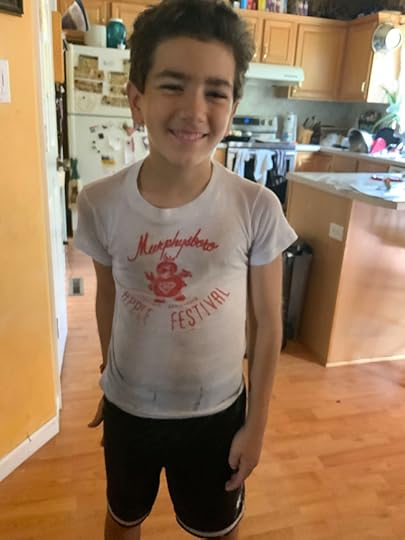
Meet “The Shirt.”
AKA “The Apple Festival t-shirt,” AKA “the Captain Applesauce t-shirt,” AKA “my summer uniform.” (My son’s title for it.)
For about 4-6 years in his early life, my oldest insisted on wearing the same Superman shirt almost every day. My middle boy never did that, but my youngest has attached to himself to this shirt, dating from 1980-something and passed on to us by my mother-in-law. It was threadbare then. Now it’s see-through. With runs.
Folks, this shirt is a size 5T.
FIVE.
T.
My son is coming up on TEN YEARS OLD.
Today, I had him take it off so I could cut his hair, and as I watched the runs stretch, I shook my head and said, “Son, one of these days, you’re going to take that shirt off and it’s going to split right down the middle. And when it does, I want you to say, ‘Shirt, I have loved you well, and you have served me well. Rest in peace.’ “
My son froze. Stared out at nothing for a long moment. Then, he said, “I think maybe I should not wash this shirt anymore. Because it might rip in the wash.”
Illustration 2: THE SOCKS
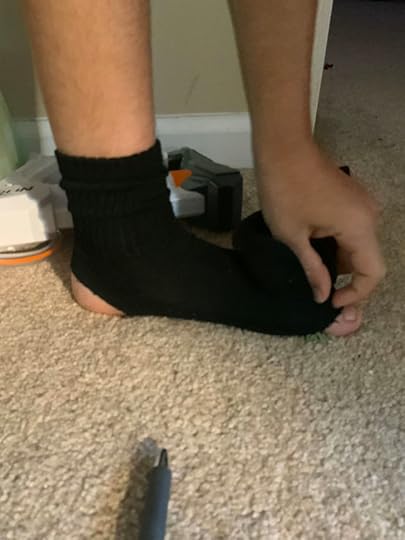
Half an hour later, I’m coaching the same child through using Zanfel scrub on poison ivy. “Take your socks off,” I said. “And throw them away.”
“WHAT?” he shrieked. “But these are my best socks!”
I got a case of the giggles that lasted a full five minutes.
You know what? I bought a bunch of No Nonsense socks like twenty years ago that are just slightly too short, and I keep waiting for them to wear out so I can get rid of them. They won’t wear out. How does he do this? EVERY WEEK there are 3-5 torn socks in my laundry. I don’t get it.
But I just shrug and say:
#boymom
August 11, 2021
the thick of it
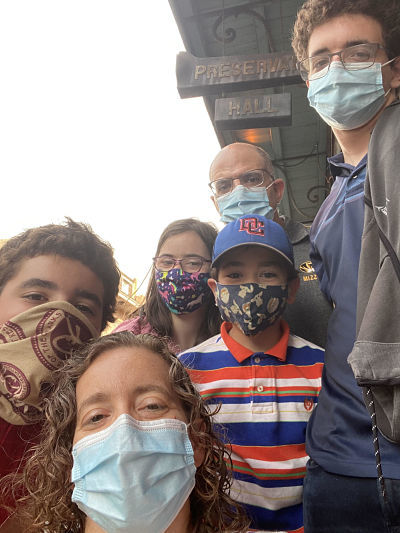 The family preparing for a show at Preservation Hall in New Orleans two weeks ago on vacation. Nicholas has a scout mask; Michael has Baby Yoda; Julianna has unicorns. Our masking preferences could not be more indicative of our personalities.
The family preparing for a show at Preservation Hall in New Orleans two weeks ago on vacation. Nicholas has a scout mask; Michael has Baby Yoda; Julianna has unicorns. Our masking preferences could not be more indicative of our personalities. 
One of my mantras over the past sixteen years of motherhood has been “This is the season of life I am in right now.” It’s a simple mantra—a recognition that what I’m experiencing is not permanent. (As an aside: sixteen years? How did that happen?)
When things started to reopen this spring, I felt suffocated by the deluge. At first, I thought it was just an adjustment phase, and I came up with another mantra: “Busy-ness is a blessing.”
But after a few weeks I realized it wasn’t adjustment, it actually WAS as busy as I thought it was. Next came the sneaking suspicion, quickly denied, because who could handle it?, that the change was here to stay.
I can no longer deny it. For better or worse, it looks like this is my new “season.”
This one involves 4 schools—5, if you count the gifted program the youngest got into. It involves marching band, soccer, color guard, scouts, 4H, and piano lessons for my children. It involves restarting the choir, promoting a book while writing another one, and volunteering on two professional committees, while also trying to control the crabgrass in the yard and make sure everyone has school supplies and clothes and gets to see their friends, while my husband holds down the fort on an extremely intense job.
And the appointments! Mental health, pre-surgery, surgery. It’s never-ending. I felt like I’d hit the jackpot yesterday because going through the boys’ closet yielded almost complete sets of school clothes, which meant I could cross ONE thing off my calendar without leaving the home. I celebrated by practicing my flute for twenty minutes.
I’m carving out time for spiritual development and counseling for myself as well, which, at this time, is a great temptation to toss off b/c I’m really okay for the moment; I’d rather have the time! But I am sticking with it, because I know that maintenance is the best way to stay “not hurting,” at least mentally. Spiritually, I think I actually do need the time.
One of my friends, who has four boys herself (three of them successfully launched) says, “You’re in the thick of it now.” I realize that this is my next two years. In fact, we’re going to have to add to it, because there will be college visits and applications and a FAFSA that I am simply dreading.
I was thinking about it yesterday as I sat gnashing my teeth while filling out my address half a dozen times on different forms for the public school gifted program registration paperwork. (For the love of all that is holy! It is ONE school district! You have a server! Do it online and MAKE THE ADDRESS AND PHONE CARRY OVER!!!! Even I, the technophobe, know that you don’t need to have paper copies for every individual office anymore!) My only comfort was, At least this is the LAST TIME. Because all the other kids are already full-time in the public schools. Summer school paperwork for private school kids doesn’t transfer over, so I have to re-fill it out every year. But entry into the gifted program makes him officially a public school student and after this there will be a 90% reduction in paperwork to fill out.
(It’s the little things, you know.)
Anyway. I’m officially rambling. But I don’t have time to craft a succinct, clever post. I just wanted to say hello from the not-void. I’m pretty sure plenty of you will reach out in one way or another in solidarity. I know I’m not the only one going through this right now.
August 10, 2021
A Song For The Road on Sale!
Guess what? A Song for the Road is a Kindle deal this week at a whopping $1.99! If you have been meaning to read and haven’t done it yet, now is the time! Sale lasts through Sunday, Aug. 15th. Click on the image to access the sale.

July 9, 2021
Five on a Friday with Anisha Bhatia
One of the great things about being a published author is how many other authors I get to “meet.” We all hear about the big, flashy books by big-name authors, but there are a host of gems that may never cross our paths. (So many books… so little time!) I get to see some of those books these days as I help other authors, and I thought I’d use my little platform to feature some stories I’ve really enjoyed.
Today, please welcome Anisha Bhatia, author of “The Rules of Arrangement,” which releases next Tuesday (July 13)!
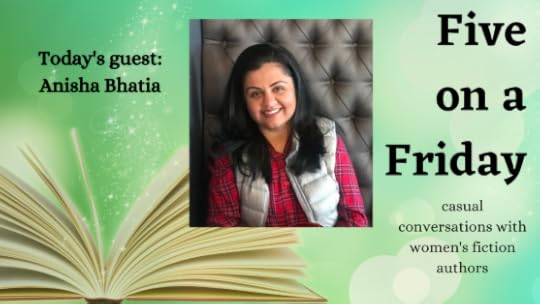

About the book:
Zoya Sahni has a great education, a fulfilling job and a loving family (for the most part). But she is not the perfect Indian girl. She’s overweight, spunky and dark-skinned in a world that prizes the slim, obedient and fair. At 26 she is hurtling toward her expiration date in Mumbai’s arranged marriage super-mart, but when her aunties’ matchmaking radars hones in on the Holy Grail of suitors—just as Zoya gets a dream job offer in New York City—the girl who once accepted her path as almost option-less must now make a choice of a lifetime.
Big-hearted with piercing social commentary, The Rules of Arrangement tells a powerful, irresistibly charming and oh-so relatable tale of a progressive life that won’t be hemmed in by outdated rules. But not without a few cultural casualties, and of course, an accidental love story along the way.
Anisha, your bio says you were born and raised in Mumbai. How much of what we see in “The Rules of Arrangement” is an amalgam of your own experiences and/or observations growing up?
A bunch of it is, for sure. Large parts of it are based on observing the world around me. Although Zoya is not me, the first chapter is inspired by an amusing incident – my aunt rushing into our house on a lazy Sunday as if it was an emergency, to confront my parents about what they were doing and why they hadn’t started searching for boys for me. My parents looked sheepish and asked if she could help since she had a large network of social connections. I was all of 22, and in the room when it happened, and they were discussing me like I wasn’t there. I remember thinking it was hilarious, but I couldn’t laugh out loud because it was a “serious” topic. I’ve never forgotten it!
That’s hilarious! And I thought I had family stories.  I can see how your own experience helped birth such colorful supporting characters. I’m a total sucker for a colorful supporting cast in a book. All your characters are so vivid! Can you tell us about Zoya, Arnav, Lalit, Sheila Bua (especially Sheila Bua!) et al? Where did they come from? How did you develop them?
I can see how your own experience helped birth such colorful supporting characters. I’m a total sucker for a colorful supporting cast in a book. All your characters are so vivid! Can you tell us about Zoya, Arnav, Lalit, Sheila Bua (especially Sheila Bua!) et al? Where did they come from? How did you develop them?
Thank you!
After my second child, I took up an evening class at the University of California, San Diego, simply to get out of the house. The class was called Creating Unforgettable Characters, and Sheila Bua was the result of the final assignment! She was the catalyst for this story, even before Zoya.
Growing up in India, you weren’t allowed to be too opinionated. It could mark you as a firebrand (read: not good daughter-in-law material), but a lot of girls have impertinent commentary running through their heads, and I wanted to capture that. So, Zoya’s funny irreverent voice and Sheila Bua came together in a story.
Arnav was only supposed to be a side character, but he developed organically and got more “screen time” as the story developed, to my consternation! I had not intended to add an element of romance, but it surprised me by its addition and how natural it felt to the story.
Lalit was the hardest character to write. I realize that I need to be sympathetic toward a character I’m writing, no matter how “bad” they are. If I don’t like them, I can’t write them. For the longest time, Lalit escaped me, and one of my astute writer friends told me it was because I didn’t like him. I was horrified. It was like being told you don’t like one of your kids – ha!
Those darned characters. You have to like them even when they’re being buttheads! Let’s go back to your main character, Zoya. She is charmingly clueless about, well, everything, which makes her personal epiphanies and ultimate triumph all the more satisfying. How much of this did you plan, and how much just happened as the story developed? Did this book develop in layers, or did you already know, going in, everything you wanted to accomplish?
It absolutely developed in layers. Zoya was even more clueless in Draft 1, almost ditzy. But the layers kept being added in each edit and surprised me with how organic they felt. So much so that I berated myself at not having thought of them all at once while writing the first draft!
The Rules of Arrangement touches on lots of hot topics for women: body shape, intimacy, marriage vs. work, etc. It also lets me, a white reader with zero experience with Indian culture, see all these issues through a new lens. What do you hope readers will take away from it?
The underlying thing I wanted to say with this book, which is why I wrote it, is for women, for girls from traditional societies, who wonder if there are choices besides what they’ve been told. This is to tell them that there are choices out there and its ok to choose them and they can do that without breaking away from family.
I’d like readers to understand that that fighting your mind, your conditioning, is one of the hardest things a person can do. And that the people around them, their elders, the aunties and uncles, all of them have a story, all of them had dreams just like you do. They are who they’ve become because of that story.
And foremost, I wrote this story for girls, for women everywhere, especially South Asian, who’ve been made to feel “less” than because of their appearance or weight or skin. I want to tell them that you are enough, you deserve all the good things, all the chances you get – take those chances and don’t hold yourself back! Changing your beliefs is slow, it doesn’t happen overnight, but it does happen! One step at a time, slow and consistent.
I love that. You either grow or atrophy; it’s the reality of human existence. We often don’t give ourselves (or others) enough grace in the process of growth. So, last question: Do you have a new project in the works? Can you tell us about it?
I do! I’m hoping to write about mental health and motherhood and an intersection of the two. I am working on the first draft and I have no idea where I’m going with the story except for a vague blueprint. There’s a reason it’s called the first draft from hell!
I’m totally with you there. Good luck, and thanks for visiting! Everybody, check out The Rules of Arrangement, releasing next week!
June 29, 2021
When Mom Ain’t Happy…
 Photo by Andrea Piacquadio on Pexels.com
Photo by Andrea Piacquadio on Pexels.comYesterday, a friend and I helped organize donations for our local Refugee & Immigration Services. The lovely young woman who was giving us directions gestured at a group of stuff on the floor and said, “And if you have time, you could try to inventory those… um…”
“Car seats?” my friend and I said, laughing.
“Yes!” she said. “I guess we have to have someone come in and see if they’re still safe.”
“Most of those look brand new,” I observed. “They still have tags on them. Most of them are forward-facing boosters. I only see one infant carrier…”
And the young woman bowed out, relieved to have a couple of moms on the job.
It was a bit surreal. For so long I have identified as a mom of littles, and staring at that room full of boosters, I realized all over again: that’s not me anymore. I’m a mom of three teens (yes, even a twelve year old is a teen) and one boy who is blessedly clinging to little boy-dom, even as he charges through life sweaty-headed with a compound bow in one hand and a soccer ball in the other.
There is a richness in parenting teens that’s hard to describe, a sense of awe that such a tiny thing could get so big, all arms and legs and height and opinions, even when they’re different from mine in ways that pierce deep. At being able to talk about things at a much more intellectually stimulating level than you can with, say, a two-year-old. Or a five year old.
But of course, those who can talk at a more sophisticated level can also push buttons at a more sophisticated level.
And those who have more sophisticated ways of thinking also have tougher emotional struggles. We’re way beyond a temper tantrum because Mom won’t let you have dessert until you eat your broccoli. I never carried the emotional burden of my children in those days.
But now?
I was feeling reasonably positive yesterday afternoon, having gotten a smidgen of writing work accomplished despite the interruptions that have become par for the course the last few months. Then one of my children walked in after summer school with a face about a light-year long, moping and wallowing and throwing problems at me, as if I needed any more, and I fell right off a cliff into a wallow-pit of my own.
And then my husband came home sick on a night I’d been counting on his help with chauffeuring. It spiraled down from there, until, when pulling my daughter’s color guard flag out of the van four hours later, I accidentally knocked over her bike and threw a tantrum of my own. “WHY DOES EVERYTHING HAVE TO BE SO HARD? I’M SO SICK OF EVERYTHING BEING HARD!”
Anyone who replies with a comment to the effect of “Enjoy it! It goes so fast!” will forthwith be banished from my blog. (Kidding. Sorta not really.) That saccharine platitude, inevitably lobbed at me when I’m at my wits’ end, brings me nearer bloodcurdling screams than almost anything else in the universe. Of course it goes so fast. I’m well aware. Have been for a decade and a half. But telling me to enjoy being at my lowest? Really? How is that helpful?
(Generally, I need to go to confession after my reaction to that statement.)
So what is the purpose of this post? I don’t know. Keeping it real, I guess. I don’t blog about parenthood much anymore, and when I do I try to keep it positive. But sometimes we all need to be affirmed: Sometimes this gig is HARD. And when it is, it’s okay not to enjoy it!




